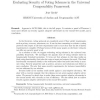Free Online Productivity Tools
i2Speak
i2Symbol
i2OCR
iTex2Img
iWeb2Print
iWeb2Shot
i2Type
iPdf2Split
iPdf2Merge
i2Bopomofo
i2Arabic
i2Style
i2Image
i2PDF
iLatex2Rtf
Sci2ools
ACNS
2004
Springer
2004
Springer
Evaluating Security of Voting Schemes in the Universal Composability Framework
In the literature, voting protocols are considered secure if they satisfy requirements such as privacy, accuracy, robustness, etc. It can be time consuming to evaluate a voting protocol with respect to all these requirements and it is not clear that the list of known requirements is complete. Perhaps because of this many papers on electronic voting do not offer any security proof at all. As a solution to this, we suggest evaluating voting schemes in the universal composability framework. We investigate the popular class of voting schemes based on homomorphic threshold encryption. It turns out that schemes in this class realize an ideal voting functionality that takes the votes as input and outputs the result. This ideal functionality corresponds closely to the well-known ballot box model used today in manual voting. Security properties such as privacy, accuracy and robustness now follow as easy corollaries. We note that some security requirements, for instance incoercibility, are not ...
| Added | 20 Aug 2010 |
| Updated | 20 Aug 2010 |
| Type | Conference |
| Year | 2004 |
| Where | ACNS |
| Authors | Jens Groth |
Comments (0)

